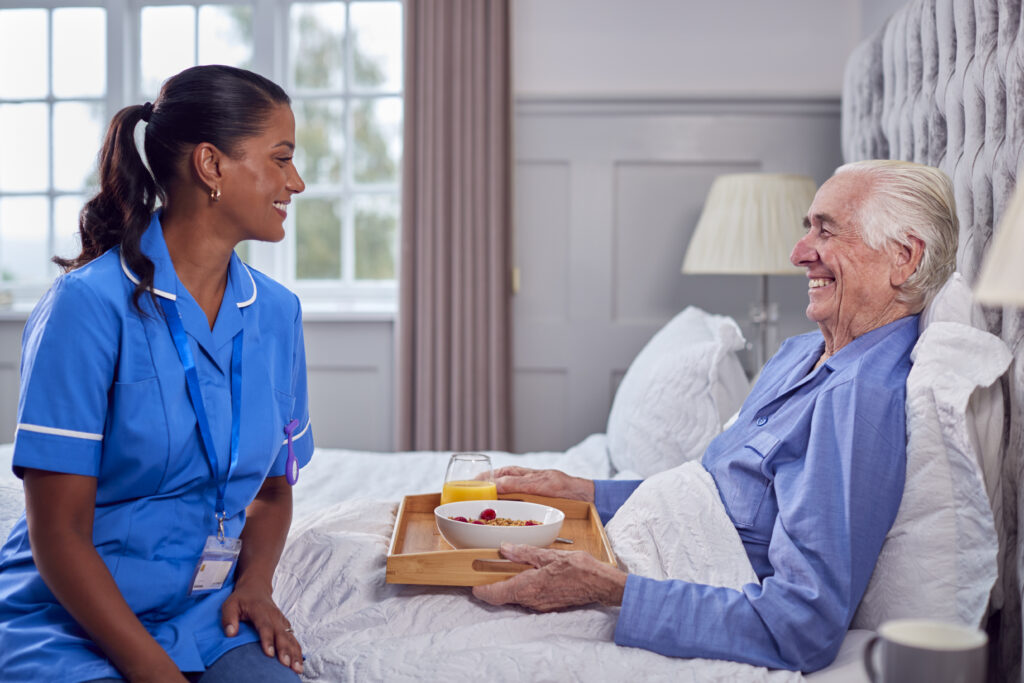Our agency has been serving the community of Eastern Massachusetts since 1997. We are family owned and operated and take great pride in our relationship based care. Our caregivers are passionate about their work. They are routinely supervised and we provide follow up home visits on a regular ongoing basis. We can confidently state that our care providers are exceptional.
Our objective is to provide these services, to include value-added case management and administration, in a trouble-free and efficient manner, resulting in the highest levels of client satisfaction. CARE Resolutions, Inc. provides service in private homes, assisted living communities, hospitals, skilled nursing facilities, and rehabilitation centers. Our highly-qualified and trained caregivers are ready to help you and your loved ones with a variety of daily activities.
Hospice care and in-home cancer care are two important options for people who are facing terminal illness and want to receive care and support in the comfort of their own homes.
Both hospice care and in-home cancer care are designed to provide physical, emotional, and spiritual support to people who are facing the end of life, and both can be incredibly beneficial for patients and their families. In this article, we’ll take a closer look at hospice care and in-home cancer care, including what they are, how they differ, and why they might be the right choice for someone facing terminal illness.
Hospice care is a type of medical care that is focused on providing comfort and support to people who are facing terminal illness and have a limited life expectancy. Hospice care is typically provided in a patient’s home, although it can also be provided in a hospice facility or nursing home. Hospice care is designed to address the physical, emotional, and spiritual needs of patients and their families, and it is typically provided by a team of medical professionals, including doctors, nurses, social workers, and chaplains.
Hospice care is often recommended for people who have a terminal illness and have decided to forego curative treatment in favor of comfort care. This may be because the person has decided that the side effects and risks of treatment outweigh the potential benefits, or because the person has reached a point where treatment is no longer effective. Hospice care can be provided to anyone with a terminal illness, regardless of age, and it is often covered by insurance, including Medicare and Medicaid.
Hospice care involves a range of services designed to provide comfort and support to people who are facing terminal illness. These services may include:
Pain management: Hospice care focuses on controlling pain and other symptoms, such as shortness of breath and nausea, to help patients feel as comfortable as possible.
Emotional and spiritual support: Hospice care involves providing emotional and spiritual support to patients and their families, including counseling, chaplain services, and bereavement support.
Medical care: Hospice care includes medical care to manage symptoms and keep patients comfortable, including medication management and wound care.
Family support: Hospice care involves supporting the entire family, including providing education and resources to help them understand and cope with the patient’s terminal illness.
Coordination of care: Hospice care involves coordinating care with other medical professionals and ensuring that patients have access to all the services they need.
CARE Resolutions case managers and staff to assist in maintaining and improving the clients quality of life while they age in place.

Hospice care is typically provided by a team of medical professionals, including doctors, nurses, social workers, and chaplains. The team is led by a hospice medical director, who is responsible for overseeing the patient’s care and coordinating with other members of the team. The hospice team works closely with the patient’s primary care physician and other medical professionals to ensure that the patient’s needs are being met.
In addition to medical professionals, hospice care may also involve volunteers who provide companionship and support to patients and their families. These volunteers may visit with patients, help with household tasks, or provide transportation to appointments.
CARE Resolutions provides non-medical care like personal care, companionship, and homemaker services.
In-home cancer care is a type of medical care that is provided to people with cancer in the comfort of their own homes. In-home cancer care may be recommended for people who are receiving treatment for cancer and need additional support to manage the side effects of treatment or for people who are no longer responding to treatment and are receiving comfort care.
In-home cancer care may involve a range of services, depending on the patient’s needs. These services may include:
Medication reminders: In-home cancer care may involve medication reminders, and reporting any symptoms to other members of the medical team.
Symptom management: In-home cancer care may involve managing symptoms such as pain, nausea, and fatigue.
Wound care: In-home cancer care may involve providing wound care, including cleaning and dressing wounds.
Nutrition: In-home cancer care may involve helping patients with nutrition, including providing meals and supplements as needed.
Coordination of care: In-home cancer care may involve coordinating care with other medical professionals, such as doctors and nurses, and ensuring that patients have access to all the services they need.

If you are considering In-Home Senior Care, CARE Resolutions is a local 24/7 home care agency, give us a call today.
CARE Resolutions aspires to provide that unmatched security, comfort and care to all those whom we serve. Fill out our Get Started form now.
In-home cancer care is typically provided by a team of medical professionals, including nurses, social workers, and other healthcare professionals. The team is led by a medical director, who is responsible for overseeing the patient’s care and coordinating with other members of the team. In-home cancer care may also involve volunteers who provide companionship and support to patients and their families.
In-home cancer care may be provided by a variety of organizations, including hospitals, hospice organizations, and home health agencies. It may be covered by insurance, including Medicare and Medicaid, depending on the patient’s specific situation.
CARE Resolutions provides non-medical care like personal care, companionship, and homemaker services.
Hospice care and in-home cancer care are similar in that they both involve providing medical care and support to people in the comfort of their own homes. However, there are some key differences between the two:
Focus of care: The primary focus of hospice care is providing comfort and support to people who are facing terminal illness and have a limited life expectancy. The primary focus of in-home cancer care is providing support to people with cancer who are receiving treatment or who are no longer responding to treatment.
Treatment goals: Hospice care is focused on managing symptoms and providing comfort, rather than trying to cure the patient’s illness. In-home cancer care may involve both curative and comfort care, depending on the patient’s situation.
Coverage: Hospice care is often covered by insurance, including Medicare and Medicaid, while in-home cancer care may or may not be covered depending on the patient’s specific situation.
Hospice care and in-home cancer care can be excellent options for people who want to receive medical care and support in the comfort of their own homes. There are several reasons why someone might choose hospice care or in-home cancer care:
Comfort: Both hospice care and in-home cancer care are designed to provide comfort and support to patients and their families. This can be especially important for people who are facing terminal illness or who are experiencing the side effects of cancer treatment.
Convenience: Receiving care at home can be more convenient for both patients and their families, as it eliminates the need for long trips to the hospital or clinic.
Familiar surroundings: For many people, being in their own home can provide a sense of familiarity and comfort that can be difficult to find in a hospital or other medical facility.